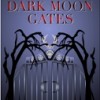The Human Skull and Head in History and Folklore
An obvious symbol of our own mortality, humans have been fascinated with--and frightened of--the skull for many millenia. It appears in our artwork, our stories, and in the darkest depths of nightmare. Here I present you with gruesome and fascinating facts about skulls and heads.
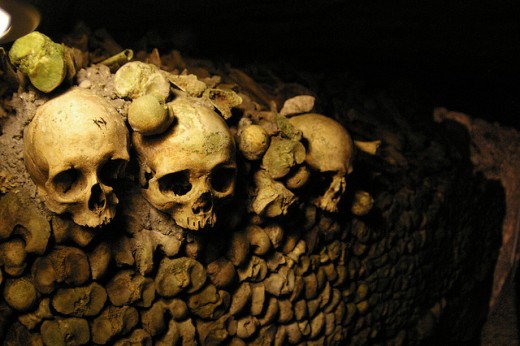
The Skull as Spirit
For thousands of years, the head has been a symbolic of the mind, spirituality and Oneness. In his "L'Ascension de l'humanite" (Paris 1958) Herbert Kuhn suggests that the decaptitation of corpses during prehistoric times marked man's discovery of the spiritual principle residing in the head, as opposed to the vital principle which resided in the body as a whole.
All "Dem Bones"
The skull actually consists of 28 bones. The only one that moves is the mandible or lower jaw.
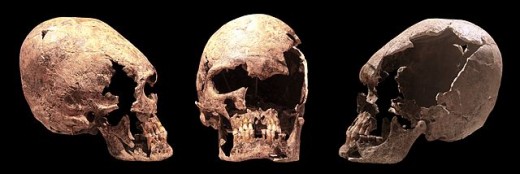
Head Flattening
Head flattening or cranial deformation is the practice of binding an infant's head so that the skull grows into a conical shape.
The Mayans only did this with children of the priestly and noble castes, while Caribbean islanders bound the heads of male children so that their skulls would grow strong enough to survive an arrow to the head.
In Peru, remains of one Inca sacrifice shows that the child's head had been shaped to resemble a double-peaked mountain.

Anne Boleyn's Headless Ghost
"With her head tucked underneath her arm . . . "
Anne Boleyn, second wife of King Henry VIII was beheaded for alleged adultery (so that the King might conveniently find himself a wife capable of bearing sons).
It is said that she requested a French executioner as she felt the French were more skilled at beheadings.
Anne's headless ghost is said to walk the Tower of London where she was executed, and she has been seen in other places including Hever Castle, Blickling Hall, Salle Church and Marwell Hall.
Secret Messages
Seeking to ensure the secrecy of his message, the Persian nobleman, Histaeus shaved the head of a trusted slave and tattooed his message there. Once the hair grew back, the slave was dispatched with instructions to shave his head at his destination.
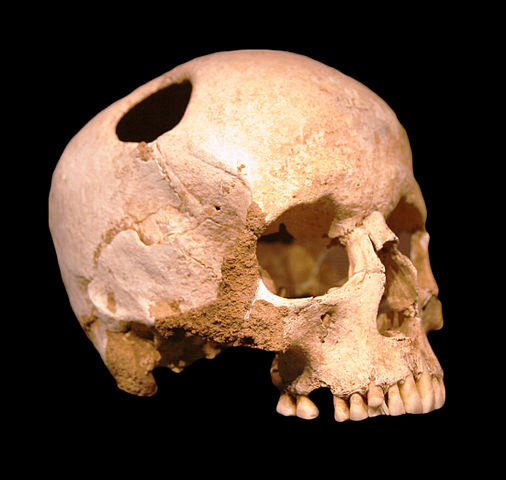
Holes in your head?
Trepanning is the surgical boring of a hole in the head. This type of surgery occurred as far back as 7,000 years ago and perhaps even dates to Cro Magnon times.
Trepanation was done to release "evil spirits" from the head, for spiritual reasons and for physical ailments from headaches to brain swelling caused by battle injuries. This procedure was carried on without anesthesia and could take as much as 12 days.
During the Middle Ages and up to the 18th century, trepanning was a common cure, similar to bloodletting. Prince Phillip of Orange was trepanned 17 times!
Amazingly about 60% of patients survived.
Today, devotees of the procedure believe that it will bring the higher consciousness and return to us the imagination and openness of childhood. Don't try this at home!
Headless Horseman
Home late after a hectic night on the road? Curl up with a Headless Horseman and a spooky novel.
2 oz vodka
3 dashes bitters
Ginger ale
A slice of orange
Mix vodka and bitters in a collins glass. Add ice, top with ginger ale and garnish with a slice of orange.
What's your opinion of skulls?
Bran the Blessed
Celtic legend tells of Bran the Blessed, a king of the ancient Britons. When he died, his followers cut off his head and carried it with them for eighty years.
They consulted him as an oracle and his enchanted head regaled them with poetry and song so that while they listened, they did not feel the passage of time.
Eventually they buried the head on the White Mount, where the Tower of London now stands.
While the head remained buried, no enemy could conquer Britain. But Arthur dug it up, destroying the magic and soon thereafter Britain was overrun by the Saxons.
The Heads of Their Enemies
The Celts often took the heads of enemies killed in battle, and kept these both as trophies and as offerings to the gods.
The great stone shrine at Roquepertuse had skull-niches in the wall, some filled with representations of heads and others filled with actual skulls.
The Greek historian, Diodorus Siculus wrote, "They embalm in cedar oil the heads of the most distinguished enemies, and preserve them carefully in a chest, and display them with pride to strangers, saying that for this head one of their ancestors...refused the weight of the head in gold."
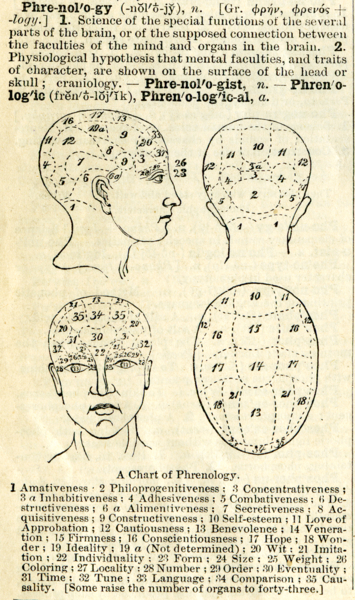
Bumps on Your Head?
Phrenology is the study of the shape of the head and the lumps thereupon. Widely popular in antebellum America, it is now in decline.
This pseudo-science claims that the shape and size of the cranium will reveal the character of the person and the quality of their mind.
Del Close's Skull...or Not
"I knew him, Horatio; a fellow of infinite jest..."
Del Close, an actor and comedian who worked with SCTV and Saturday Night Live willed his skull to the Goodman Theatre. He said he wanted to play Yoric in Hamlet.and expected to be credited for the part.
Charna Halpern his executor and professional partner donated a skull to the theater in a televised ceremony.
It was later revealed that the skull was not Close's and that she'd purchased it from a medical supply company.
Talk about "to be or not to be"!

The Jolly Roger
When we refer to pirates and the Jolly Roger flag, it's usually the skull and crossbones flag of Edward England which comes to mind.
But each pirate had their own, personalized Jolly Roger. The device below is that of Edward Teach, or "Blackbeard."
The hourglass signified that time was running out, the arrow, heart and drops of blood meant that blood would be spilled unless you surrendered and the horns and cloven feet of the skeleton suggested that Blackbeard was in league with the Devil.
No one is certain where the name "Jolly Roger" comes from. Some believe it may be a corruption of the French, "joli rouge" meaning pretty red, referring to the bloody banner used by early pirates.
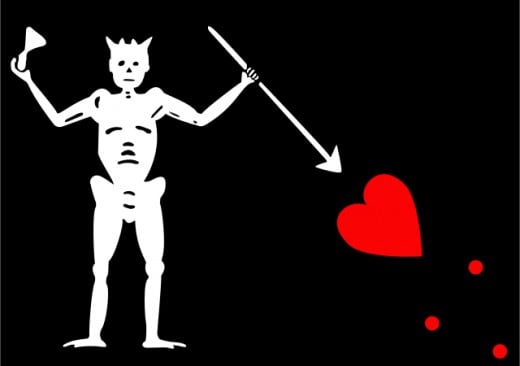
Blackbeard's Head
The notorious pirate Blackbeard lost his head in 1718. It took 20 sword wounds and 5 gunshot wounds to bring him down.
His body was tossed overboard and his head was hung from the bowsprit of the Adventure, the British ship that captured him.
What's purported to be his skull now sits in a glass case at The Mariners' Museum in Newport News, Va.
Madame la Guillotine
The French Revolution just wouldn't have been the same without the "fortuitious" invention and improvements to the Guillotine, which offered a more efficient, and allegedly more humane method of execution.
Contrary to popular legend, the French doctor, Joseph Ignace Guillotin (1738 - 1814) did not invent the Guillotine, although he did promote its use. A precursor of this device existed as early as 1307.
The Guillotine's first execution took place on April 25, 1792, in Paris with the execution of Jacques Nicolas Pelletier. The last Guillotine execution was on September 10, 1977 in Marseille, France, when the murderer Hamida Djandoubi was beheaded.
Madame la Guillotine claimed some 13,800 lives during the Revolution (only a small portion of the lives lost). Of those, only about 8-9% were aristocrats, 6-7% were priests and 20% were burghers (the prosperous middle-class). The rest were mainly the small craftsmen and farmers that the Revolution alleged to be aiding.
Tipping the Executioner
Beheading was seen as an easy death, and was generally reserved for the nobility and others of importance. Common folk were usually executed in manners that caused greater pain and prolonged suffering.
The craft of the executioner was a fine art and took many years of apprenticeship to master. Executioners practiced on pumpkin-headed dummies and animals in slaughter houses.
It was customary to tip the executioner in thanks for him doing as swift and painless a job as possible.
Are Severed Heads Conscious?
A swiftly severed head seems to retain consciousness long enough to perceive that it has been severed.
During the French Revolution and well into the 1800s, there were numerous reports of severed heads changing expression, and seeming to be aware that they had been decapitated.
Some scientists claim that this is due to involuntary muscle movements. Lets hope Mythbusters never takes this one on!
Transfusing a Head
In September of 1880 a Dr. Dassy de Lignères was provided with the head of a murderer approximately three hours after the execution. He transfused the head using the blood supply from a live dog.
In an interview with the French newspaper Le Matin (3 March 1907) he claimed that color returned to the head, that the lips stammered and the eyelids twitched and that "the whole face wakened into an expression of shocked amazement," for about 2 seconds.
Heads Giving Birth
Greek Mythology contains several instances of heads giving birth.
Athene, goddess of Wisdom, Justice and the Arts was born from Zeus' head.
Pegasus, the winged horse, was born when Perseus slew the Gorgon Medusa. In some tales the Horse was born when the blood of Medusa's severed head fell into the foam of the sea. In others, Pegasus emerges from her body after the decapitation, along with a warrior named Chrysaor who was born carrying a golden sword.
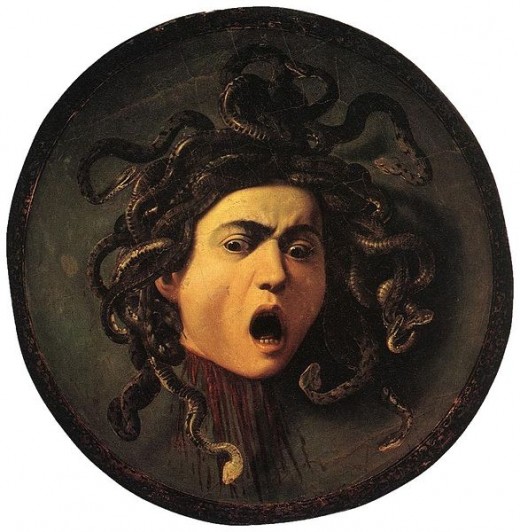
Medusa's Head
Medusa herself, had her hair turned to snakes because she had angered Athena. This made her so hideous that seeing her would turn a person to stone.
Perseus slew Medusa and used her head to slay the Sea-dragon Cetus. Later he gifted the head to Athena, which she placed on her breastplate (or shield) "the Aegis."
Orpheus' Singing Head
Orpheus, who gave his name to the "Orphic Mysteries" traveled to Hades to retrieve his beloved Eurydice, who had been bitten by a snake.
Following the rescue, a band of frenzied Bacchantes, worshipers of Dionysos/Bacchus, asked Orpheus to play music for their dancing. But his lyre would play only sad strains, and so they attacked him, their shouting overwhelming the sound of the magic instrument.
Orpheus was torn to pieces and his head and lyre were cast into the Hebru. As the river bore them along, the head continued to sing and the lyre to give forth its music.
A Home for a Skull
The skull is so important to the Babanki people of the Camaroon grasslands that representations of the head decorate almost all utilitarian items.
They revere the ancestral spirits embodied in the skulls of deceased ancestors. These are kept by the eldest male of a lineage.
When a family relocates, they must first build a dwelling to house the skulls.
If they cannot preserve an ancestor's skull, they perform a ritual in which libations are poured upon the ground and then utilize dirt from that location to represent the skull of the deceased.
Shrunken Heads
We've all seen pictures of shrunken heads--or maybe one of those rubber replicas. But did you ever ask yourself why anyone would bother to shrink a head in the first place? m
The Jivaro people of the Andes feud a lot between their tribes. But if they manage to kill the enemy, they must perform an elaborate ritual to purify themselves of the killing.
During this time, the warrior is temporarily ostracized from the tribe and a skeleton is painted on his body. In a process which takes several days, he removes the skull (through the neck) and shrinks the enemy's head, creating a "Tsantsa" which traps the spirit of the enemy inside the head, where it cannot haunt him.
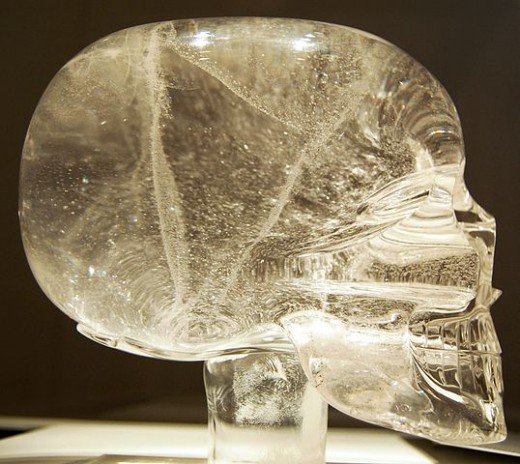
The Crystal Skulls
Hoaxes or ancient objects of power?
The origins of the Crystal Skulls are unknown, and though some have been debunked as recently created hoaxes, others seem to reveal that they were created by a technology that we do not have access to today.
Those who have worked with the skulls claim that they receive information in the form of visions and flashes of insight, and many believe the skulls to have healing power.
The Piltdown Skull
The discovery in 1908 of Piltdown Man caused a stir in the archaeological world. It was believed to be the missing link between apes and humans.
But in 1953, scientists re-examined the skull and found it to be a fake -- the skull of a medieval man with the jawbone of an orangutan.
Photo Credits
Thanks to the following folks for the use of their photos.
Via Wikimedia Commons by Public Domain
Anne Boelyn artist unknown
Phrenology Webster's Dictionary
Blackbeard's Flag The Open Clipart Library, this version uploaded by Fred the Oyster
Medusa Carravagio
Via Wikimedia Commons by Creative Commons Share Alike
Elongated Skull Rama
Trepanated Skull Rama
Edward England's Flag WarX, edited by Manuel Strehl
Crystal Skull Manuel de Corselas
Via Flickr by Creative Commons Share Alike
Catacomb Skulls Adam Baker
This article was originally published on my website in 1998.

More Articles
That Scary Death Card - What You Need to Know About This Terror of the Tarot
Why getting the Death Card in a reading can be a good thing.
